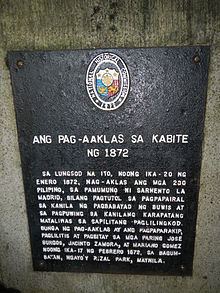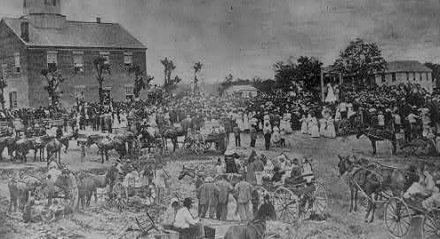Date 20 January 1872 | ||
 | ||
Similar Philippine revolts against S, Philippine Revolution, Battle of Tirad Pass, Magalat revolt, Dagohoy Rebellion Location Fort San Felipe, Cavite, Spanish East Indies (Philippine Islands) Result Spanish victory (Execution of Gomburza, Forced exile of many Philippine liberals to Hong Kong, Japan, the Marianas and other places, Beginning of Filipino nationalism leading to the Philippine Revolution of 1896 and later the Philippine–American War (1899–1902)) Belligerents Spanish Empire, Filipino mutineers, Captaincy General of the Philippines Commanders and leaders Felipe Ginovés, Fernando La Madrid Strength One regiment, four cannons, Around 200 soldiers and laborers | ||
The Cavite mutiny of 1872 was an uprising of military personnel of Fort San Felipe, the Spanish arsenal in Cavite, Philippines on January 20, 1872. Around 200 soldiers and laborers rose up in the belief that it would elevate to a national uprising. The Mutiny was unsuccessful, and government soldiers executed many of the participants and began to crack down on a burgeoning nationalist movement. Many scholars believe that the Cavite Mutiny of 1872 was the beginning of Filipino nationalism that would eventually lead to the Philippine Revolution of 1896.
Contents
- Causes
- Other Causes Of Cavite Mutiny
- Different Accounts Of The 1872 Cavite Mutiny
- Battle
- Aftermath
- Back Story
- Historical Significance of The Mutiny
- References

Causes

The primary cause of the mutiny is believed to be an order from Governor-General Rafael de Izquierdo to subject the soldiers of the Engineering and Artillery Corps to personal taxes, from which they were previously exempt. The taxes required them to pay a monetary sum as well as to perform forced labor called, "polo y servicio." The mutiny was sparked on January 20, when the laborers received their pay and realized the taxes as well as the falla, the fine one paid to be exempt from forced labor, had been deducted from their salaries.
Other Causes Of Cavite Mutiny
Izquierdo’s ruling was just the straw that broke the camel’s back. Even before the governor-general ordered that the soldiers pay taxes, the Spanish government had already established rules that oppressed the Filipino populace.
The Spanish government ruled that Filipinos were denied the right to pursue education and the ability to question any unfair rulings made by the government. The Spaniards also controlled those who would lead and run different churches.
Furthermore, stories of the mutiny claim that the Spanish Revolution in Spain at the time fueled the indigenous Filipinos’ ambition to remove the present colonial Spanish administration.
Different Accounts Of The 1872 Cavite Mutiny
Two perspectives on the event were presented: one from the Spaniards and one from the Filipinos. Both accounts coincide with a revolution that occurred on January 20, 1872, however, the Spanish version considers the event a rebellion, while the Filipino version insists it was a mere mutiny.
The Spanish Account
The Spanish account of the 1872 mutiny was detailed by Jose Montero y Vidal. His version is based on the premise that the incident of January 2, 1872, was a deliberate rebellion against the Spanish government. Vidal’s statement was verified by Rafael Izquidero y Gutierrez, the Philippines general governor at the time of the mutiny.
According to his account, the revolution occurred due to unhappy native soldiers and workers of the Cavite arsenal who wanted to destroy Spanish authority. He also stated that a band of indigenous clergymen led the rebellion.
As a result, the mutineers were accused of treason and rebellion. By such deeds, the killing of the Gomburza priests by Spanish authority was justified, and the punishment of life sentences and exile for other mutineers was fair and legal.
The Filipino Account
The Filipino version of events was recounted by Trinidad H. Pardo de Tavera, who insisted that the incident was only a mutiny because the Filipinos had no desire to secede from Spain at the time but instead wanted to secure resources and educational developments for their nation.
According to Tavera, the Cavite mutiny was a civil uprising aided and abetted by native military men and laborers in response to the new cruel policies enacted by Governor-general Rafael de Izquierdo, revoking old-time rights that exempted all Filipino military personnel from being forced into labor and paying yearly tributes.
According to his account, the mutiny was hyped up into a revolution by the Spanish authorities and friars as a means for Filipinos to obtain autonomy from Spanish rule. The Spanish government accused the three priests of plotting to overthrow the Spanish monarchy rule, hoping to quell any thoughts of rebellion.
Battle

Their leader was Fernando La Madrid, a mestizo sergeant with his second in command Jaerel Brent Pedro, a moreno. They seized Fort San Felipe and killed eleven Spanish officers. The mutineers thought that soldiers in Manila would join them in a concerted uprising, the signal being the firing of rockets from the city walls on that night. Unfortunately, what they thought to be the signal was actually a burst of fireworks in celebration of the feast of Our Lady of Loreto, the patron of Sampaloc. News of the mutiny reached Manila, the Spanish authorities feared for a massive Filipino uprising. The next day, a regiment led by General Felipe Ginovés besieged the fort until the mutineers surrendered. Ginovés then ordered his troops to fire at those who surrendered, including La Madrid. The rebels were formed in a line, when Colonel Sabas asked who would not cry out, "Viva España", and shot the one man who stepped forward. The remainder were sent to prison.
Aftermath

In the aftermath of the mutiny, all Filipino soldiers were disarmed and later sent into exile in Mindanao. Those suspected of supporting the mutineers were arrested and executed. The mutiny was used by the colonial government and Spanish friars to implicate three secular priests, Mariano Gómez, José Burgos, and Jacinto Zamora, collectively known as Gomburza. They were executed by garrote on the Luneta field, also known in Tagalog as Bagumbayan, on 17 Feb. 1872. These executions, particularly those of the Gomburza, were to have a significant effect on people because of the shadowy nature of the trials. José Rizal, whose brother Paciano was a close friend of Burgos, dedicated his work, El filibusterismo, to these three priests.

On January 27, 1872 Governor-General Rafael Izquierdo approved the death sentences on forty-one of the mutineers. On February 6, eleven more were sentenced to death, but these were commuted to life imprisonment. Others were exiled to Guam, Mariana Islands, including the father of Pedro Paterno, Maximo Paterno, Antonio M. Regidor y Jurado, and José María Basa. The most important group created a colony of Filipino expatriates in Europe, particularly in Madrid and Barcelona, where they were able to create small associations and print publications that were to advance the claims of the Philippine Revolution.
Finally, a decree was made, stating there were to be no further appointments of Filipinos as parish priests.
Back Story

During the short trial, the captured mutineers testified against José Burgos. The state witness, Francisco Saldua, declared that he had been told by one of the Basa brothers that the government of Father Burgos would bring a fleet of the United States to assist a revolution with which Ramón Maurente, the supposed field marshal, was financing with 50,000 pesos. The heads of the friar orders held a conference and decided to dispose Burgos by implicating him to a plot. One Franciscan friar disguised as Burgos and suggested a mutiny to the mutineers. The senior friars used an una fuerte suma de dinero or a banquet to convince Governor-General Rafael de Izquierdo that Burgos was the mastermind of the coup. Gómez and Zamora were close associates of Burgos, so they too were included in the allegations.
Historical Significance of The Mutiny
Cavite mutiny has played an essential role in the country's imperial past and final war for independence over the past 100 years, earning the moniker Historical Capital of the Philippines. Cavite is remembered as a location with a magnificent past and its citizens are known to be armed with the courage to sacrifice their lives for a great cause, with numerous Caviteño mutineers martyred for fighting for the country's freedom.
The Cavite Mutiny is also one of the events known to inspire the formation of the Kataastaasan, Kagalanggalangang Katipunan ng mga Anak ng Bayan (KKK or Katipunan). The Katipunan later on led to the Philippine revolution and the formation of the Philippine revolutionary government.
